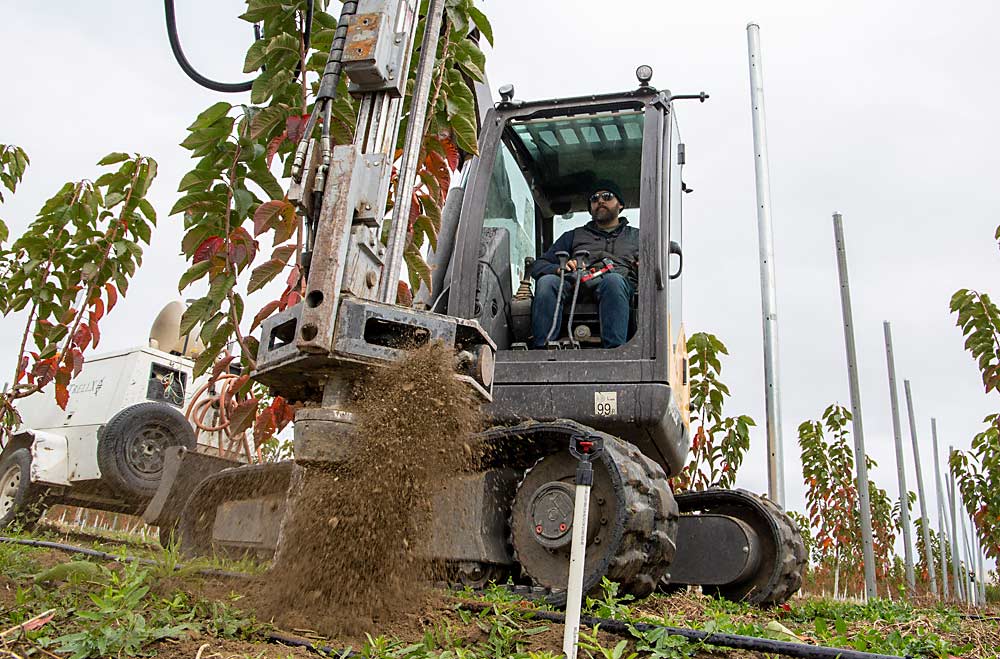
Editor’s note: This story has been updated since the print version published on May 15 to more clearly describe Bleyhl Co-op’s products and services as they relate to trellises and superstructures.
Today’s orchard trellises often support more than just trees.
Posts that extend two or three feet above the top of the canopy hold shade netting, rain material or windbreaks. In some cases, the fabric completely encloses blocks and bin-loading areas, meaning the coverings need a door for semitrucks to drive through.
For such orchard infrastructure projects, engineer Mark De Kleine uses the term superstructures,or protective cropping systems. They all change the mathematics of how a trellis works. Do-it-yourself growers often ask him for standardized blueprints and lessons he doesn’t know how to give.
“Everybody wants to know how to build an airplane so they can go fly it,” said De Kleine, president and founder of TrellX, an orchard engineering company in Prosser, Washington. De Kleine researched trellis principles over five years ago for the Washington Tree Fruit Research Commission, but the extras skew the equations in ways even he can’t standardize.
Each orchard presents its own engineering problems, he said. Differences in slope, soil structure and tree architecture represent trade-offs in strength and flexibility elsewhere.
Even the most common question, how deep to bury posts, varies for soil type, size of net panels, anticipated crop yields and so on. For another example — how close to an end post to place an anchor — engineers would also ask where the irrigation system starts and want to know about surrounding county easements. De Kleine has even changed anchor types to adjust to changes in ground conditions within one block.
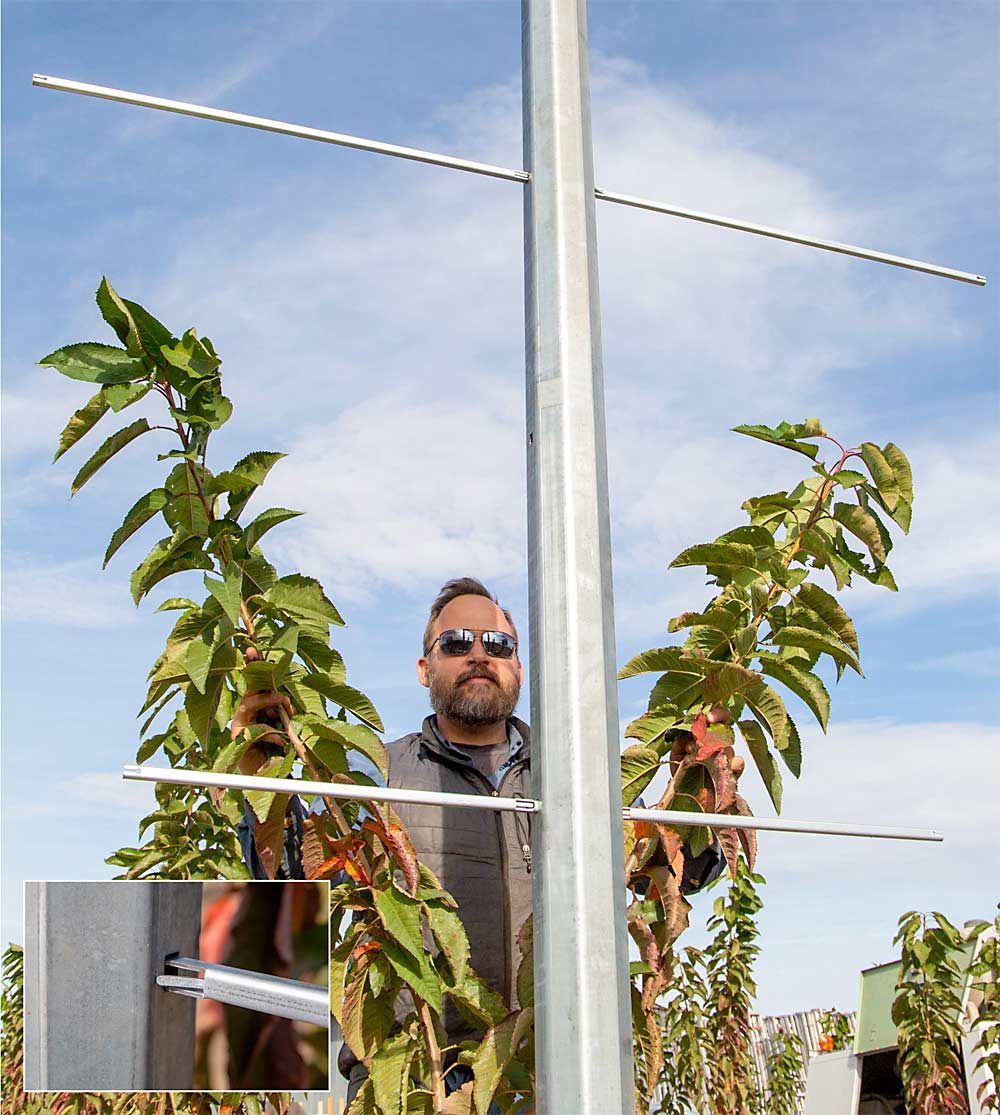
Despite all those caveats, De Kleine and Ken Hite, a partner in All-Phase Agricultural Engineering of Union Gap, Washington, discussed with Good Fruit Grower some general principles about superstructures (see “Strategies for superstructure success” below).
Hite, who also designs trellises and sometimes collaborates with De Kleine, does not use the term superstructure. He prefers simply calling them what they are — shade structures or wind structures, for example.
Whatever they’re called, the extra structures run roughly double the cost of an uncovered trellis, and demand is increasing every year as orchardists plant more Honeycrisp and other sun-sensitive varieties, weather becomes more erratic and destructive, and economics tighten to the point where one missed crop can break financial backs, especially in the West.
“It’s coming this way, absolutely,” Hite said. “I’m asked about coverings more and more.”
It used to be mostly for apples, but cherry growers are getting into the mix more, too.
“It’s just reality now to ensure a crop every year,” said Lupe Muñoz, farm manager for River Valley Orchards, a Central Washington company building new covered cherry blocks in Grandview and Benton City.
Examples
River Valley contracted TrellX to design and install trellis to support both trees and superstructures with rain, hail, sun and bird protection over Santina, Early Robin and Black Pearl cherries in two 16-acre orchards. The 35-foot-wide material panels will peak over each row and deflect water to run off in the middle of the alleys.
To support the River Valley Orchards projects, De Kleine and the farm owners opted for 18-foot octagonal steel posts, similar in strength to a circle but cheaper to roll, with three feet in the soft soil, periodically strengthened by grout that binds with the surrounding dirt. They will stretch 12.5-guage tensile cable to 250 pounds of tension in both directions. Though the posts will stand vertically, removable steel crossarms will support the two-leader trees trained into a Y-shape. They require no welding, cutting down on De Kleine’s labor, which is expensive for him these days, too. The trees in this orchard were planted in the spring and small enough for him to work around.
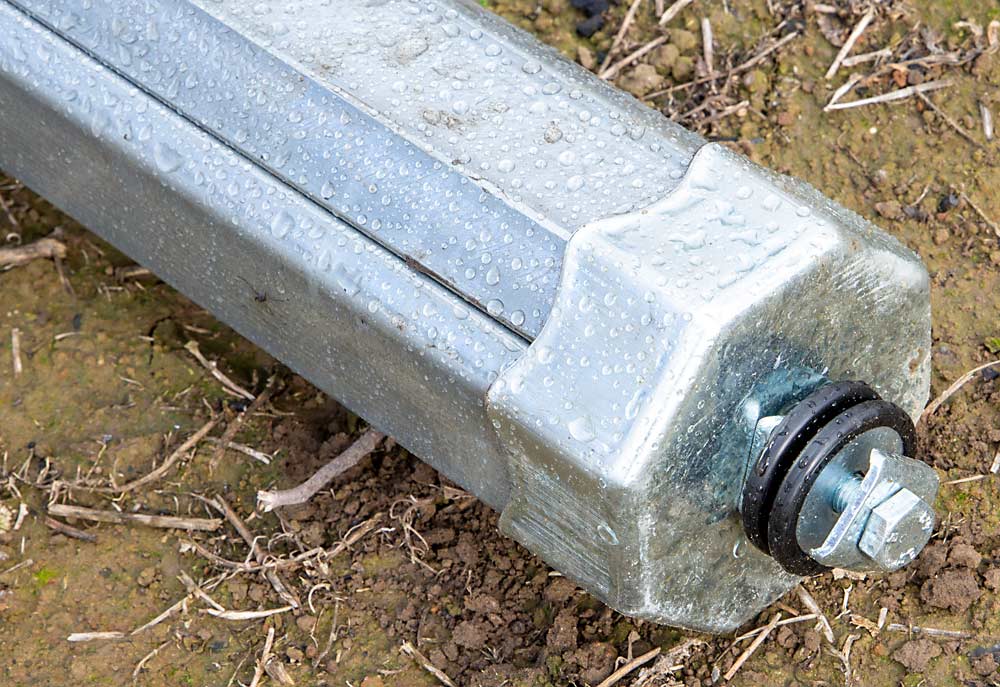
In Delano, California, TrellX is building a mechanically retractable superstructure that will cover four new low-chill cherry varieties from International Fruit Genetics at a new farm planted by Grapery, a company better known for table grapes.
The covering will serve two purposes, said Jack Pandol, founder and majority owner of Grapery. It will protect the trees from rain and give him more control over chilling hours and heat units, to perhaps hasten fruit maturity and thus gain a potential edge in the marketplace. He wants the ability to open and close the coverings day-to-day, based on weather and moisture metrics.
“Covered agriculture is a big deal and will become more so in the future,” said Pandol, also a partner in International Fruit Genetics. Gone are the days where retailers and shoppers would tolerate inconsistent crops due to bad weather.
New to the cherry business, Pandol is starting small with 40 acres, though his economic analysis tells him the payoff of consistent crops will be worth the extra capital for the covering system. He hopes the development will serve as a demonstration orchard for other Central California cherry growers, some of whom have lost two or three of the last five crops due to weather.
The system is new, even for De Kleine, who is inventing on the fly and would like to explore automating it.
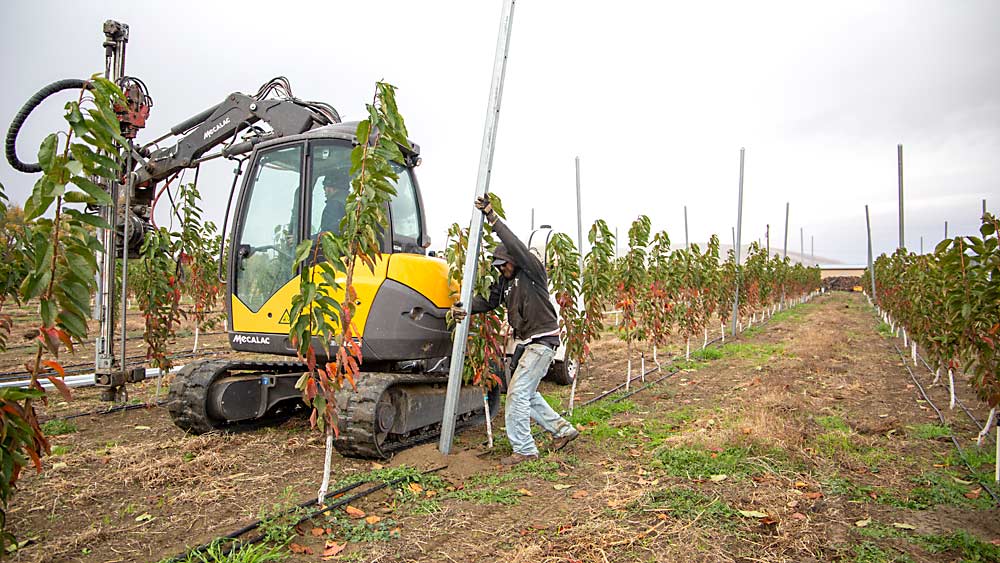
Stretched fabric over orchards has generated less interest in the East, where sun is less of a problem, said Paul Wafler of Wafler Farms in Wolcott, New York. He is preparing for a different future, though.
In New York, growers typically just drape nets directly over tree canopies. Wafler also uses drape netting but is one of the only orchardists in the area to support it with periodic posts that reach about 2 feet above the tops of his trees, he said. Well known for his alternating row widths and tree angles, he drapes the nets over two rows at a time.
He still uses wood posts because they can be drilled and hammered into. He has tinkered with concrete posts, but the cost remains too high, he said.
His systems also are prepared for the future, Wafler said. At any time, they could support stretched rain or hail protection with the addition of reinforcing side posts. He would make sure the material is retractable for snow.
His superstructure additions are motivated by high-color strains of Honeycrisp “that don’t play nice with heat,” he said. Climate change is real, he said, though not his main driver.
Also, somewhat accidentally, he noticed better growth under the nets in places.
Complexity and variability
The complexity and variability of superstructure trellises require too much specialization for some supply companies. Bleyhl Co-op, for example, sells trellis posts, wire and a variety of anchors, and offers designs and advice for trellises but not rain and sun fabric, said Ned Rhode, viticulture and orchard division director for the Grandview, Washington, company.
“It’s so much all over the board,” Rhode said about superstructures. “Everybody wants to do something a little different.”
Hite’s biggest piece of advice is to plan for trellis and protective covering support systems that allow for growth and changes in automation.
In superstructures, the trick is finding the sweet spot: strong enough to hold everything in place but not too strong that it wastes capital, De Kleine said. Engineers help with that. Growers, even those skilled in construction, may over- or underbuild.
For growers who know they want a superstructure, these tips are intended to help them crystallize some of their goals before they seek engineering help, not give them a plan of action for solo construction.
“If I set principles, I’d have to make them for the most extreme case,” De Kleine said.
—by Ross Courtney
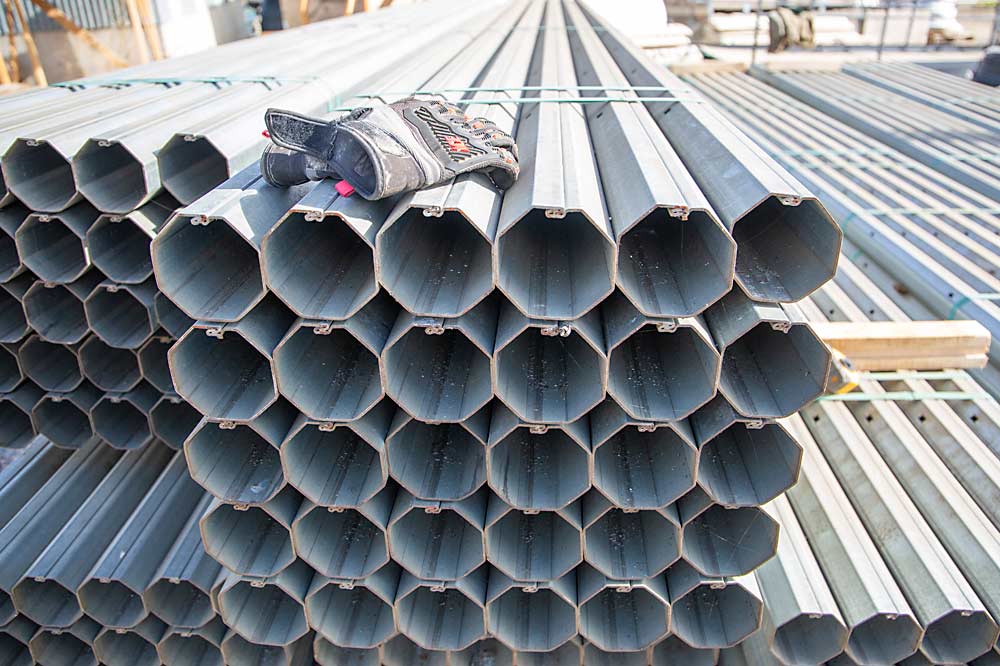
Strategies for superstructure success
Each superstructure — orchard infrastructure that supports both trees and crop protection fabric — presents its own engineering challenges, but Mark De Kleine, president of TrellX of Prosser, Washington, and Ken Hite, a partner in All-Phase Agricultural Engineering in Union Gap, Washington, offered the following tips for growers to consider when preparing to build:
—Install trellises either before you plant or right after. Retrofitting an established orchard is far more expensive.
—Know the difference between engineering and design. Engineering will mathematically gauge strength versus force. Design is about the number of wires or the degrees of trellis angles. Both are important, but: “I’ve fixed a lot of trellises that were designed but not engineered,” De Kleine said.
—Decide horticultural questions first, such as V-trellis versus vertical, row spacing and tree height. Do you need to drive trucks and equipment, such as tower sprayers, hedgers or platforms, underneath the fabric?
—Don’t forget rootstocks. They grow at different speeds and heights, which affects trellis and structure requirements. “That’s one that gets missed a lot,” Hite said.
—Decide what you want to protect your crop from. Rain and hail protection materials have a tighter weave than sun and bird netting, so they will require more support.
—Decide where your irrigation will be. That will affect the location of anchors and, therefore, the strength of end posts.
—Check for easements on surrounding property that can affect anchor location. De Kleine and Hite use plot maps to make that part of their initial design procedure.
—Know your wind patterns and wind speeds.
—Think about your labor budget for opening and closing netting panels.
—Think ahead about longevity. In the age of rapid variety development, some growers plan to keep an orchard for only 10 years. Others expect decades from their orchard. Those factors change engineering approaches.
—Concrete poles are an alternative to steel or wood, but concrete has been prohibitively expensive for the Northwest. Hite does not even recommend it. Whatever the material, each comes with its own engineering principles.
—Show up to your engineer with maps. De Kleine and Hite use computer 3D modeling to design and engineer orchards. Changing your mind on a computer rendering is cheaper than after construction has started.
—On a V-trellis, build superstructure posts separately from the posts that support the trees, to avoid wind failures with a heavy crop, Hite recommended. On a vertical trellis, it’s OK to make posts that hold both trees and fabric — usually every second post — taller and stronger. De Kleine said both approaches work as long as they are engineered to support the extra load.
—Consider installing covers in sections of roughly 30 feet by 70 feet. Then, if one section fails, it won’t bring down the whole block.
—R. Courtney

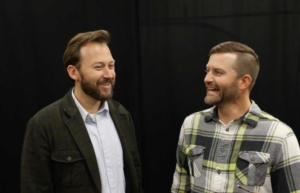
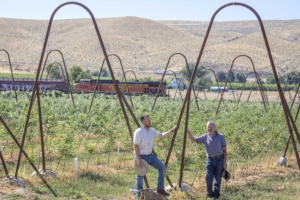
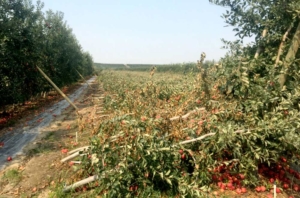





Leave A Comment